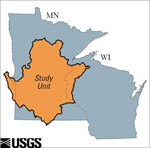Minnesota Water Science Center

UMIS NAWQAUSGS IN YOUR STATEUSGS Water Science Centers are located in each state. 
|
Ground Water Study Unit SurveysStudy unit surveys provide a broad assessment of water-quality conditions in regional aquifers. In the Upper Mississippi River Basin NAWQA study, two study unit surveys were done. A total of 50 domestic wells completed in the Prairie du Chien-Jordan aquifer (Figure 1) in Minnesota and Wisconsin were sampled. Half of those wells were completed in the aquifer in areas where it is unconfined (not overlain by younger bedrock units or glacial tills). The other 25 wells withdrew water from the aquifer in areas where it is overlain by younger bedrock units or glacial tills. Water samples from the 50 wells were analyzed for concentrations of 192 water-quality constituents, including major ions, nutrients, trace metals, pesticides, VOC's, radon, and tritium. Concentrations of nutrients varied between the two confinement settings of the aquifer (Figure 2). Reduced nitrogen species (ammonia and organic forms of nitrogen) were generally higher in the less oxygen-rich water in confined portions of the aquifer (Figure 3). The oxidized form of nitrogen, nitrate, occurred in higher concentrations in water from more oxygenated unconfined portions of the aquifer. Nitrate concentrations in drinking water are of concern because elevated concentrations of nitrate in drinking water are associated with the occurrence of methemoglobinemia (blue-baby syndrome), and have been tentatively associated with increased incidence of birth defects, stomach cancer, and leukemia. Nitrate concentrations are commonly highest in ground water in agricultural areas, where high rates of nitrogen fertilizers are applied to cropland. Pesticides and VOC's were detected in trace amounts (usually less than one microgram per liter (part per billion)) in water samples from many of the 50 wells. Because many of the analyses indicated nondetection of compounds, frequencies of detection, rather than concentration ranges are shown in Figure 4 and Figure 5. As seen in Figure 4, atrazine and its breakdown product deethylatrazine were the most frequently detected pesticide compounds in water samples. Other pesticides detected in water samples from those wells included diazinon, metolachlor, simazine, alachlor, and 2,6-diethylanaline. Pesticides were more frequently detected in wells in areas where the aquifer is unconfined (Figure 6). As seen in Figure 2, carbon disulfide and methyl chloride were the most frequently detected VOC's in water samples. Carbon disulfide is emitted by the manufacture of synthetic fibers, but may also be created by naturally-occurring bacteria in soils. A wider variety of VOC's were detectable in water samples from unconfined portions of the aquifer (Figure 7). Radon concentrations in water samples were relatively high--most exceeding the withdrawn USEPA Maximum Contaminant Level of 300 picocuries/Liter for drinking water (Figure 8). Radon is generated by the natural fission of uranium and radium, both of which occur in low concentrations in many rocks and soils. The health threat from radon is associated with the migration of radon from water to the air inside of buildings, where it is inhaled by the residents. Radon gas is inhaled, where it emits alpha particles that may damage surrounding lung tissues. Elevated concentrations of radon in air have been associated with increased incidence of lung cancer. |